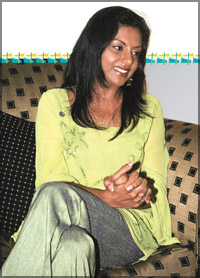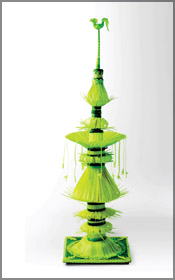|

Compiled by Ruwini Jayawardana
Yashoda sheds light on preserving cultural heritage
Ruwini Jayawardana
|

Yashoda Wimaladharma Picture by Palitha Gunasena
|
As you travel through Sri Lankan history and its picturesque
destinations and enriching cultural experiences you would be sure to
come upon certain traditional aspects which not only possess the charm
and richness of the past but are fast disappearing from the present.
One such cultural heritage is Gok Kalawa, the art form which uses
Gokkola (young coconut fronds) to create diverse decorative
constructions. This type of folk art is not only endemic to the island
but it is probably Sri Lanka's truly national art.
With breath-taking beauty and of sacred value, it is no wonder that
these designs and work of art are on focus in the calendar presented by
Sri Lanka Telecom for the year 2008. The company had for the past few
years released calendars adorning pictures with facts connected to some
of Sri Lanka's most treasured and endemic natural possessions.
This year their attention had shifted from nature to works of fine
art made using Gokkola. As another point of creating awareness towards
our rich heritage, lead actress Yashoda Wimaladharma expressed her
opinion on the delights of Gok Kalawa.
"The origin of this form of art dates back to an era which transcends
way beyond the period when Buddhism came to Sri Lanka. It was a pagan
art form in villages used to worship their rural deities.
With the advent of Buddhism with its own unique form of art such as
temple paintings and sculptures, the art of Gok Kalawa took a different
turn," she said.
"Gokkola is the ivory coloured, tender leaves of the coconut plant.
The coconut plant is one of the most treasured plant of all time as
every part of it has its use. It is often referred to as the Kapruka,"
Yashoda explained.
A significant feature connected with this form of art is it retains a
strong association with the planetary forces of astrology, the rituals
of exorcism and blessing. For instance, a portrayal of the Pun Kalasa is
a symbol of abundance and prosperity.
|

Pun Kalasa |

Magul Poruwa |

Gok Pahana |
Therefore in most traditional Sinhala marriage ceremonies this
auspicious abject is kept near the Magul Poruwa. The traditional Magul
Poruwa itself is made of Gokkola and a fresh creation is made for each
wedding couple as a representation of their new life.
You may be able to recall that each Magul Poruwa differs from the
other. Some showcase a twin-swan design while others represent lotus
flowers or any design found in ancient sculptures and frescos. The sun
and moon designs of the Gokkola Sesath on either side represents a
pledge that the couple will never be parted until there is day and
night.
"It is considered as one of the five mythical objects sacred to gods.
Those days the Pun Kalasa was made of Gokkola. The pleasant fragrance
set off by the tender leaves brought a refreshing feeling to your mind.
You did not need any other form of air fresheners. Unfortunately this
custom is fading away as people are on the verge of using substitutes
such as gold painted pots for decor," she expressed adding that apart
from marriage ceremonies it is also used in religious rituals such as
Tovils, Shanthikarmas and at Pirith Mandapayas as well as for
house-warming events.
"This enhances the power of the sermons and adds to the bountifulness
evoked by the chants," Yashoda said. Similarly the Kumara Kalasa is a
clay pot adorned in Gokkola which is used in the Kalu Kumara Samayama, a
ritual practiced to exorcise the malefic influence of the demon called
Kalu Kumaraya (dark prince) off young women.
"Hindu traditions are also embedded in our practices. We possess a
mixed culture," she pointed out.
"Our traditions and culture is unique. These practices are not found
anywhere else in the world. That should be our foundation in approaching
other new trends. As a person who has a passion for what is ours I
believe that more importance should be given to this form of art. It
should be preserved for future generations."
##############################
'Skills' through photography
Wehelle Piyathilake, Maharagama special corr.
A special type of photographic exhibition organised by Handicap
International titled 'Skills' is open for the public at the Fort Railway
Station till January 5. 'Skills' is a travelling photo exhibition
featuring the works of four reputed photographers: Manika Vanderpooten,
Gemunu Amarasinghe, Anoma Rajakaruna and Philippe Merchez who have
captured the essence of the vocational abilities of people with
disabilities.
"This exhibition will not only highlight the vocational talents of
persons with disabilities, but it will also bring forth those who
encourage others to take bold steps to fulfill their goals and
aspirations," head of Handicap International F. Bernard told the Daily
News. 'Skills' confers a message to the ordinary people on how to assist
persons with disabilities.
The talents competition organised by the Development with Disabled
Network (DWDN) which was sponsored by Handicap International. |

